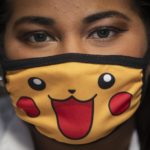Compiled by Tim Anderson, 16 July 2020
A number of recent English language scientific studies have come out in support of face mask wearing, as an important supplemental means of controlling the COVID19 pandemic. Several of these are listed below.
While it is certainly true that there is a scientific debate over masking, it is not at all true to say that there is “no evidence” in support of masking as a defence against COVID19. Of course there was necessarily little evidence of any sort on the new COVID19 virus until 2020, but this year there have been a number of studies. Recent reports have ranged from cautious to very strong support for mask wearing, especially as a supplemental means of virus control and especially in crowded areas.
At the cautious end a New England Journal of Medicine report said that “universal masking alone is not a panacea. A mask will not protect providers caring for a patient with active Covid-19 if it’s not accompanied by meticulous hand hygiene, eye protection, gloves, and a gown” (Klompas, Morris, Sinclair, Pearson and Shenoy 2020).
Two other cautious reports came from the University of East Anglia and CIDRAP. The East Anglia report said that “wearing facemasks can be very slightly protective against primary infection from casual community contact, and modestly protective against household infections when both infected and uninfected members wear facemasks” (Brainard, Jones, Lake, Hooper and Hunter 2020). The CIDRAP report claimed there was “no evidence” masks were effective in COVID19 controlled, but accepted that “surgical masks likely have some utility as source control … from a symptomatic patient in a healthcare setting to stop the spread of large cough particles and limit the lateral dispersion of cough particles. They may also have very limited utility as source control or PPE in households” (Brosseau and Sietsema 2020).
A Lancet article called masking “a useful and low-cost adjunct”. This paper addressed some “uncertainty”, in particular because “the WHO had not yet recommended mass use of masks for healthy individuals … [this was in part because] previous research on the use of masks in non-health-care settings had predominantly focused on the protection of the wearers and was related to influenza or influenza-like illness.” However this report concluded that “mass masking for source control is in our view a useful and low-cost adjunct to social distancing and hand hygiene during the COVID-19 pandemic” (Cheng, Lam and Leung 2020).
A British Royal Society study found that universal masking could help manage the pandemic and prevent a second wave of infections: “even when it is assumed that facemasks are only 50% effective at capturing exhaled virus inoculum … [even] home-made facemasks consisting of one facial tissue (inner layer on the face) and two kitchen paper towels as the outer layers achieved over 90% of the function of surgical mask … [nevertheless] a high proportion of the population would need to wear facemasks to achieve reasonable impact of the intervention … facemask use by the public, when used in combination with physical distancing or periods of lock-down, may provide an acceptable way of managing the COVID-19 pandemic and re-opening economic activity” (Stutt, Retkute, Bradley, Gilligan and Colvin 2020).
Another study in the American Thoracic Society found that masks could help as a preventive measure: “the mask can mitigate the current pandemic, as it may reduce coronavirus in aerosols and respiratory droplets … Although universal masking may seem tedious and is criticized by the lack of high-quality supporting evidence, we think it is reasonable to re-consider such a measure in all but sparse areas in the public” (Wong, Teoh, Leung, Wu, Yip, Wong and Hui 2020).
Yet another study showed that mask wearing was “associated with” lower mortality and that where “societal norms and government policies supporting mask-wearing by the public [this was] independently associated with lower per-capita mortality from COVID-19”. They concluded that “the use of masks in public is an important and readily modifiable public health measure” (Leffler, Ing, Lykins and Hogan 2020).
A study published at the National Academy of Sciences found that face mask wearing was “the most effective means”, when combined with other measures, to prevent the spread of COVID19. The authors wrote: “the wearing of face masks in public corresponds to the most effective means to prevent inter-human transmission, and this inexpensive practice, in conjunction with extensive testing, quarantine, and contact tracking, poses the most probable fighting opportunity to stop the COVID-19 pandemic, prior to the development of a vaccine” (Zhang, Li; Zhang; Wang; and Molinae 2020).
Similarly, a preliminary review of evidence called mask wearing a low cost and effective intervention. “The preponderance of evidence indicates that mask wearing reduces the transmissibility per contact by reducing transmission of infected droplets in both laboratory and clinical contexts. Public mask wearing is most effective at stopping spread of the virus when compliance is high. The decreased transmissibility could substantially reduce the death toll and economic impact while the cost of the intervention is low” (Howard et al 2020).
This page may be updated as new reports come in.
Sources:
Brainard, Julii; Natalia Jones, Iain Lake, Lee Hooper, Paul R Hunter (2020) ‘Facemasks and similar barriers to prevent respiratory illness such as COVID-19: A rapid systematic review’, MEDRXIV, 6 April, https://www.medrxiv.org/content/10.1101/2020.04.01.20049528v1.full.pdf
Brosseau, Lisa M and Margaret Sietsema (2020) ‘COMMENTARY: Masks-for-all for COVID-19 not based on sound data’, CIDRAP, 1 April, https://www.cidrap.umn.edu/news-perspective/2020/04/commentary-masks-all-covid-19-not-based-sound-data
Cheng, Kar Keung; Tai Hing Lam and Chi Chiu Leung (2020) ‘Wearing face masks in the community during the COVID-19 pandemic: altruism and solidarity’, The Lancet, 16 April, https://www.thelancet.com/journals/lancet/article/PIIS0140-6736(20)30918-1/fulltext
Howard, J.; Huang, A.; Li, Z.; Tufekci, Z.; Zdimal, V.; van der Westhuizen, H.; von Delft, A.; Price, A.; Fridman, L.; Tang, L.; Tang, V.; Watson, G.L.; Bax, C.E.; Shaikh, R.; Questier, F.; Hernandez, D.; Chu, L.F.; Ramirez, C.M.; Rimoin, A.W. (2020) ‘Face Masks Against COVID-19: An Evidence Review’, Preprints 2020, 2020040203https://www.preprints.org/manuscript/202004.0203/v1
Klompas, Michael; Charles A. Morris, Julia Sinclair, Madelyn Pearson, and Erica S. Shenoy (2020) ‘Universal Masking in Hospitals in the Covid-19 Era’, New England Journal of Medicine, 1 April, N Engl J Med 2020; 382:e63,https://www.nejm.org/doi/full/10.1056/NEJMp2006372
Leffler, Christopher, Edsel Ing, Joseph Lykins and Matthew C. Hogan (2020) ‘Association of country-wide coronavirus mortality with demographics, testing, lockdowns, and public wearing of masks’, Research Gate, 20 June,https://www.researchgate.net/publication/342198360_Association_of_country-wide_coronavirus_mortality_with_demographics_testing_lockdowns_and_public_wearing_of_masks_Update_June_15_2020
Stutt, Richard O. J. H. ; Renata Retkute, Michael Bradley, Christopher A. Gilligan and John Colvin (2020) ‘A modelling framework to assess the likely effectiveness of facemasks in combination with ‘lock-down’ in managing the COVID-19 pandemic’, Proceedings of the Royal Society, 10 June, https://royalsocietypublishing.org/doi/10.1098/rspa.2020.0376
Wong, Sunny H; Jeremy Y. C. Teoh, Chi-Ho Leung, William K. K. Wu, Benjamin H. K. Yip, Martin C. S. Wong, David S. C. Hui (2020) ‘COVID-19 and Public Interest in Face Mask Use’, American Thoracic Society, 15 June,https://www.atsjournals.org/doi/pdf/10.1164/rccm.202004-1188LE
Zhang, Renyi ; Yixin Li; Annie L. Zhang; Yuan Wang; and Mario J. Molinae (2020) ‘Identifying airborne transmission as the dominant route for the spread of COVID-19’, Proceedings of the National Academy of Sciences, 16 May,https://www.pnas.org/content/pnas/early/2020/06/10/2009637117.full.pdf



